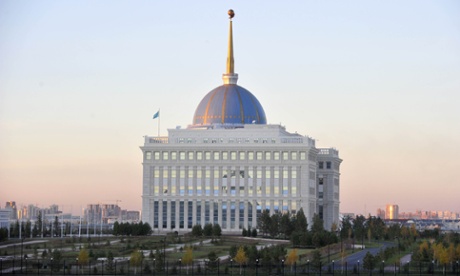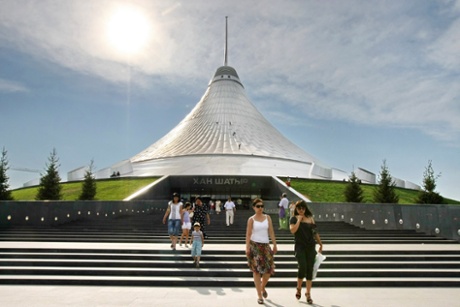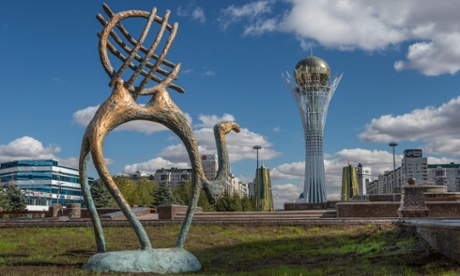Of all places, why put a city here? From the window it’s more of the same: flat, empty and endlessly vast. At 30,000 feet, a few lonely lakes polka-dot the landscape. There is no evidence of human activity. There are scarcely any trees and few distinguishing landmarks. On and on it goes – Kazakhstan is the size of western Europe, and so unremittingly flat, it’s as if some gigantic plasterer has skimmed the land. Here wolves outnumber people. Little wonder the Soviets chose this vast emptiness to hide their Gulags and their space programme, and to test their nuclear weapons. Much of it radioactive, it’s an agoraphobic’s vision of hell.
And then, out of nowhere, Astana comes glistening into view, all shiny metal and glass, implausibly rising up from the Kazakh steppe like some post-modern lego set that has stumbled into the opening sequence of Dallas. Welcome to Astana, one of the strangest capital cities on earth.
There was some early talk of Astana – which means “capital” in Kazakh – being named after the president, Nursultan Nazarbayev. After all, his name and vision are omnipresent. Since independence from the USSR in 1991, he was the first – and has been the only – president of the Republic of Kazakhstan, with an electoral victory earlier this year in which he received a comedy 97.7% of the vote.

All presidents are limited to a term of five years – except, of course, Nazarbayev, over whom the press has suspended any modicum of critical vigilance. Many Kazakh officials are quite open about it: they have chosen to do economic development first, and proper democracy (they hope) will come at some point later.
Given the billions of barrels of oil and gas that have been discovered in the country, and its very low population of only 16 million, every Kazakhstani should be a millionaire by now. One look at Astana and you can see where much of the money has gone: everywhere it’s big, flashy signature buildings, all wearing their architects’ names like fashion labels, all competing for attention like a collection of spoiled teenagers insecurely shouting: “Look at me!”
Take the Norman Foster-designed Khan Shatyr shopping centre, on the road into town from the airport. It’s the world’s largest marquee with total area of 127,000 sq metres and a height along the spire of 150 metres. A special chemical lining protects those inside from the brutal icy winter and helps it maintain its special microclimate. The artificial beach, with sand specially imported from the Maldives, requires a constant 35C. All shopping centres need a beach, of course.

For a centrally planned city, the aesthetic juxtapositions are remarkably discordant. A flashy glass pyramid. A towering set of apartments built to match Moscow University in the Stalinist empire style. A Disney version of the White House. A vase-like tower with a ball on top that the president apparently designed on the back of a napkin during a state dinner. A finance ministry shaped as a dollar bill.
Few of these buildings seem to have been designed with practicality in mind. The lifts in the pyramid go up, then left, then up, then left – it must have been incredibly expensive to get them to waltz like that. My hotel has an impressive light show on the outside of the building … and terrible Wi-Fi.
When the capital was moved here from Almaty in 1997, there was little enthusiasm among government officials who were forced to relocate. Almaty – which finds out this week if it has been successful in its bid to host the 2022 Winter Olympics – is more than a thousand kilometres further south, and is a much older and considerably classier affair. This is where Prince Harry enjoyed his winter holiday with Cressida Bonas in 2014, and where government officials spent long weekends cooking plov at their luxury dachas styled on English country houses.

The official reason for relocating to Astana – previously the provincial settlement of Tselinograd, with a crumbling Soviet housing stock – was Almaty’s location in an earthquake-prone region. But its close proximity to the Chinese border and Kazakhstan’s need to strengthen its hold on the north of the country with its large number of ethnic Russians made it logical from a strategic point of view. In this regard, the comparison with Ukraine is instructive: both have high Russian populations.
However, Nazarbayev is playing wise, carefully manoeuvring between Russia, China and the US, and is duly credited for encouraging intra-ethnic – and indeed, intra-religious – harmony. There are several large mosques in Astana, but also churches and synagogues. The baby-blue Beit Rachel synagogue is the largest in central Asia. With the threat of militant Islam on its southern border, healthy ecumenical relations are not just a communal nicety; they are a strategic necessity.
Other positives include Astana’s new university. Opened in 2010, and named after Nazarbayev (who else?), it is a point of pride for many that foreign academics staff many of the departments. Indeed, education has become a legacy issue for the 75-year-old so-called “father of the nation”. Nazarbayev has made it possible for school graduates to study overseas, all expenses paid, provided they return to Kazakhstan to work for at least five years after graduation.
Many of this new breed of foreign-educated Kazakhstanis now make their careers in Astana. Nothing whatsoever like that famous anti-hero of Kazakhstan, Borat, these new go-getting graduates increasingly dominate what is a young city both in terms of its age – Astana celebrated its 17th birthday on 6 July this year (the same day as the president’s) – and overall demographic. You don’t see many over-50s out on the streets.
This flashy toy-city is locked in a fascinating negotiation between a Soviet command-and-control past and an aspirational, market-savvy present. But out on the edge of town, all the architecture stops abruptly. All the frantic energy comes to a halt, and the vast unremitting steppe suddenly begins. Which is why Astana feels like some great existentialist parable, an attempt to overcome the terror of endless emptiness with the frantic distraction of human endeavour.
From 30,000 feet, let alone sub specie aeternitatis, it seems that Norman Foster doesn’t really stand a chance. But who knows?
Follow Guardian Cities on Twitter and Facebook and join the discussion
guardian.co.uk © Guardian News & Media Limited 2010
Published via the Guardian News Feed plugin for WordPress.

